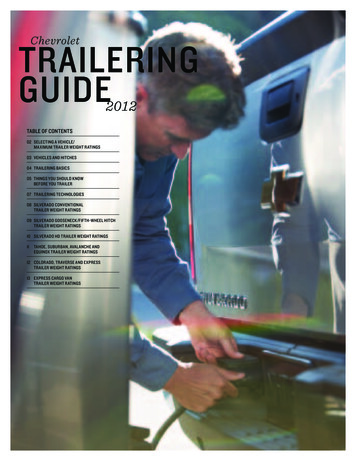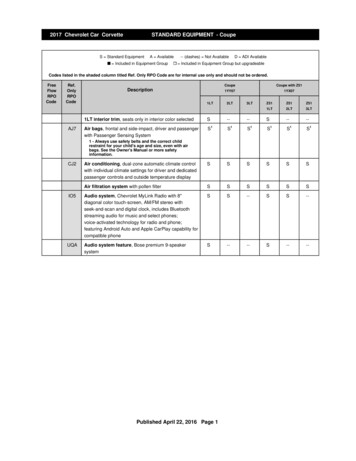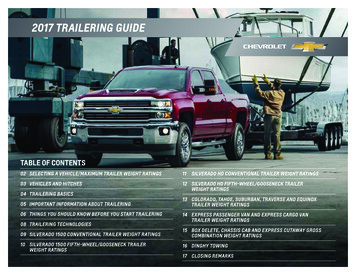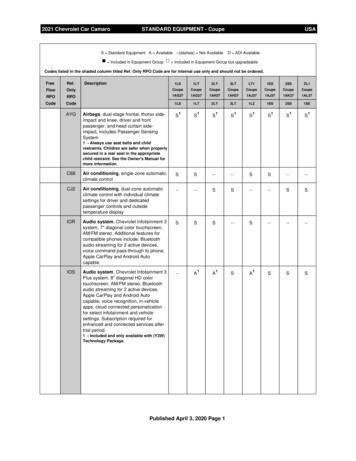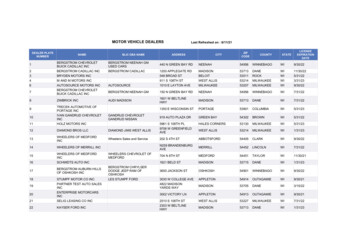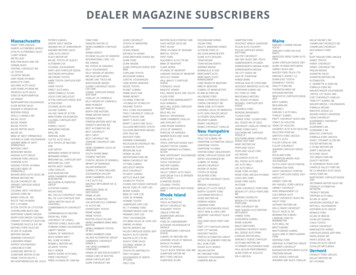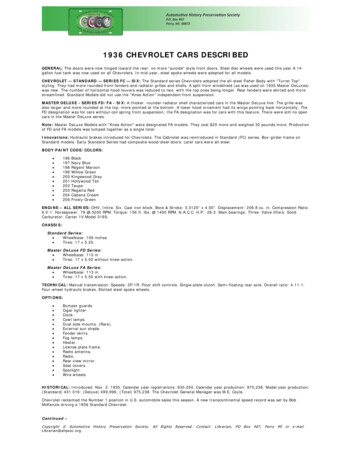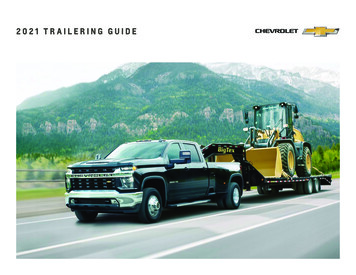
Transcription
2021 TRAILERING GUIDE
TABLE OF CONTENTS2SELECTING A VEHICLE/MAXIMUM TRAILER WEIGHT RATINGS3TRAILERING BASICS4TRAILERING TECHNOLOGIES11IN-VEHICLE TRAILERING APP13MYCHEVROLET MOBILE APP WITH TRAILERING14SMART TRAILER INTEGRATION15CAMERA TECHNOLOGIES — SILVERADO16CAMERA TECHNOLOGIES — TRANSPARENT TRAILER VIEW23CAMERA TECHNOLOGIES — SUBURBAN AND TAHOE25SILVERADO 1500 CONVENTIONAL TRAILER WEIGHT RATINGS28SILVERADO 1500 GOOSENECK/5TH-WHEEL TRAILER WEIGHT RATINGS30 SILVERADO HD CONVENTIONAL AND GOOSENECK/5TH-WHEEL TRAILER WEIGHT RATINGS33 C OLORADO, SUBURBAN AND TAHOE TRAILER WEIGHT RATINGS40TRAVERSE, BLAZER AND EQUINOX TRAILER WEIGHT RATINGS41 E XPRESS PASSENGER VAN AND EXPRESS CARGO VAN TRAILER WEIGHT RATINGS42SILVERADO BOX DELETE, SILVERADO 3500 HD CHASSIS CAB AND EXPRESS CUTAWAY GROSS COMBINATION WEIGHT RATINGS 43LOW CAB FORWARD AND SILVERADO 4500 HD/5500 HD/6500 HD GROSS COMBINATION WEIGHT RATINGS44DINGHY TOWING45CLOSING REMARKS46
SELECTING A VEHICLE/MAXIMUM TRAILER WEIGHT RATINGS (LBS.) 13The chart below gives you an idea of the maximum amount of weight you can confidently and safely trailer with different Chevrolet models when your vehicle is 007,700Suburban8,300Tahoe8,400Express 2500/3500 Passenger VanExpress 2500/3500 Cargo VanSilverado 15009,60010,00013,300Silverado 2500 HD18,510Silverado 3500 HDSilverado Series In general, a higher series number in a model indicates a greaterload-carrying capacity. In addition, a truck with a higher series number typically hasa stronger frame, a stiffer suspension and higher-capacity brakes, increasing thetruck’s ability to trailer heavy loads.1 Before you buy a vehicle or use it for trailering, carefully review the Trailering section of the Owner’s Manual. The weight of passengers, cargo and options or accessories may reduce the amount you can 8,0006,0004,0002,0000equipped. See pages 28–42 for maximum trailer weight ratings by specific model.
TRAILERING BASICS – FEATURES OVERVIEW4YOU’RE READY TO TOW.Many Chevrolet vehicles are equipped with standard and availablefeatures that make trailering safe and convenient, giving you theconfidence to tow wherever you go.Trailering TechnologiesClick for more informationCamera TechnologiesClick for more informationExtendable Trailering MirrorsClick for more informationTow/Haul ModeClick for more informationTrailer Brake ControllerClick for more informationTrailering LabelClick for more informationmyChevrolet Mobile Appwith TraileringClick for more informationIn-Vehicle AppClick for more informationWiring Harness andTrailer BrakesClick for more informationHeavy-Duty HitchesClick for more informationConventional HitchesClick for more information
TRAILERING BASICS – VEHICLES AND HITCHES5Selecting Trailering Equipment Most Chevrolet vehicles offer a variety of standardWeight-Distributing Hitch This hitch type distributes the trailer tongue load byand available equipment for enhanced trailering performance. Aside from theusing spring bars to shift some of the hitch weight forward onto the tow vehicle’sequipment described below, features such as heavy-duty cooling and extendablefront axle and rearward to the trailer’s axles.trailering mirrors may be available. See your Chevrolet dealer for more informationGooseneck and Fifth-Wheel Hitches These are designed for heavy trailering.on the model you’re interested in.Located in the bed of the truck, these hitches position the trailer’s kingpin weightSelecting the Right Hitch Choosing the right hitch and making the proper electricalnear the truck’s rear axle. Gooseneck and fifth-wheel hitches are most frequentlyconnections affects how your vehicle handles, corners and brakes, and allows you toused with travel trailers, horse trailers and other large trailers.alert other drivers of your intentions. Before selecting a hitch or trailering package,you should be familiar with the weight ratings specific to your Chevrolet vehicle,Fifth-Wheel Trailering Some Silverado models can be equipped with a fifth-wheelwhich are detailed on pages 28–42.or gooseneck trailer hitch. Follow the manufacturer’s directions for installation, but note that the hitch mustHitches It’s important to have the correct hitch equipment.be attached to the truck frame. Do not use the pickup bed for additional support. I f you’ll be towing a trailer that requires a weight-distributing hitch, be sure to useFor proper kingpin tongue load distribution and control of the trailer, the hitcha frame-mounted, weight-distributing hitch 1 and sway control of the proper size I f you have to make any holes in the body of your vehicle to install a trailer hitch, bemust be mounted so the kingpin load is placed near the rear axle centerline F ifth-wheel trailer kingpin loads are higher than conventional trailer tongue loads,sure to seal the holes if you ever remove the hitch. If they’re not sealed, dirt, waterso pay careful attention to the truck’s payload capacity and Rear Gross Axleand deadly carbon monoxide from the exhaust can get into your vehicleWeight Rating Your Chevrolet dealer can help you calculate the maximum allowable payload andConventional Hitch This consists of a hitch ball mounted to a receiver or stepGVWR required for your fifth-wheel trailering application. The weight of anybumper. Hitch balls are available in a range of sizes. Make sure that the diameteradditional equipment and all passengers other than the driver must be subtractedof your hitch ball matches your trailer coupler. Also check that the ball meets orfrom the payload weight to determine the maximum kingpin load available.exceeds the gross trailer weight rating.CONVENTIONAL HITCHESHitch Ball on Step Bumper1 Not required on Silverado 2500 HD or 3500 HD.HEAVY-DUTY HITCHESHitch ReceiverWeight-Distributing Hitchwith Sway ControlFifth-Wheel HitchGooseneck HitchLearn more about theFifth-Wheel Prep Package.
TRAILERING BASICS – WIRING HARNESS AND TRAILER BRAKES6Wiring Harness This allows you to connect the electrical components of your trailer,Trailer Brakes These are required above a 2,000-lb. trailer weight on Silverado,such as turn signals and brake lights, to the trailering vehicle. Select SilveradoSuburban and Tahoe, and above a 1,000-lb. trailer weight on all other models. (Brakemodels and all Suburban and Tahoe models feature a 7-pin wiring harness torequirements vary by state; consult state laws for actual requirements.) The moststreamline hookup of trailer lighting and brakes.common trailer braking systems are surge brakes (found primarily on boat trailers)and electric brakes (often used on travel trailers, horse trailers and car haulers).Surge brakes are a self-contained hydraulic brake system on the trailer, activatedduring deceleration as the trailer coupler pushes on the hitch ball. An electric trailerbrake system uses a brake control unit mounted inside the trailering vehicle; itoperates by sensing the vehicle brakes and then applying the trailer brakes.
TRAILERING BASICS – CLASSIFICATIONS AND OVERVIEW7TRAILERCLASSIFICATIONTYPICAL EXAMPLESTYPICAL GROSS TRAILERWEIGHT EXAMPLESTYPICAL HITCH TYPE 1Light-Duty (I)Folding camping trailer, snowmobile trailers and personal watercraft trailers(trailer and cargo combined)Up to 2,000 lbs. gross trailer weightConventional hitchMedium-Duty (II)Single-axle trailers up to 18 ft., open utility trailers and small speedboat trailers2,001–3,500 lbs. gross trailer weightConventional hitchHeavy-Duty (III)Dual- or single-axle trailers, larger boat trailers and enclosed utility trailers3,501–5,000 lbs. gross trailer weightConventional hitch or weight-distributing hitchExtra Heavy-Duty (IV)Two-horse, travel and fifth-wheel recreational trailers5,001–10,000 lbs. gross trailer weightConventional hitch, weight-distributing hitch,fifth-wheel hitch or gooseneck hitchMaximum Heavy-Duty (V)Largest horse, travel and fifth-wheel recreational or commercial trailers10,001 lbs. and above gross trailer weightConventional hitch, weight-distributing hitch,fifth-wheel hitch or gooseneck hitchTowing a trailer involves all major vehicle systems of your Chevrolet. Easy and safeGCW includes weight of the vehicle and trailer combination, including the weight oftrailering requires a properly equipped vehicle, additional trailering equipment anddriver, passengers, fuel, optional equipment and cargo in the vehicle and trailer.an appropriate trailer. It also requires loading both the vehicle and trailer properly,using safe driving techniques, meeting state and federal legal requirements, andMaximum Trailer Weight Rating This rating is determined by subtracting the towfollowing break-in and maintenance schedules. The vehicle owner is responsiblevehicle’s weight (curb weight) from the Gross Combination Weight Rating (GCWR).for obtaining the proper equipment (hitch ball, hitch type of the proper size andBase vehicle (curb) weight plus 150 lbs. each for the driver and a front passengercapacity) required to safely tow both the trailer and the load that will be towed.is used, so additional passengers, equipment and cargo weight reduce this rating.For more information, consult your Owner’s Manual or speak to a trailering expertThis rating can be found on the Trailering Information Label located on theat your Chevrolet dealer. These charts will assist in determining how to best equipdoorframe for Silverado 1500, Silverado HD, Suburban and Tahoe.your Chevrolet vehicle for trailering. To help you understand the charts, considerthese trailering factors:Axle Ratio In general, a higher axle ratio offers higher trailer weight ratings, quickeracceleration and less fuel efficiency. A lower axle ratio offers more fuel efficiencyRGAWR and GVWR Addition of trailer hitch weight cannot cause vehicle weights toand quieter vehicle operation but will have slower acceleration and lower trailerexceed Rear Gross Axle Weight Rating (RGAWR) or Gross Vehicle Weight Ratingweight ratings.(GVWR). These ratings can be found on the certification label located on the driverdoor or doorframe (no labels on Silverado 4500 HD/5500 HD/6500 HD). Make certainNote The steps described here are by no means the only precautions to be takenyou are aware of your Gross Vehicle Weight (GVW) and any state and federalwhen trailering. See the Owner’s Manual for your Chevrolet vehicle for additionaloperating requirements. GVW includes weight of the vehicle, including the weightguidelines and trailering tips.of driver, passengers, fuel, optional equipment and cargo in the vehicle.Trailering Caution If you don’t use the correct equipment and drive properly, youGCWR The Gross Combination Weight Rating (GCWR) is the total allowablecan lose control of your vehicle when you pull a trailer. If the trailer is too heavy, yourweight of the completely loaded vehicle and trailer. This rating can be found onvehicle brakes may be less effective. You and your passengers could be seriouslythe Trailering Information Label located on the doorframe for Silverado 1500,injured. Pull a trailer only after you have read the information in this guide andSilverado HD, Suburban and Tahoe. Make certain you are aware of your Grossfollowed the steps on the following pages. See the Owner’s Manual for your ChevroletCombination Weight (GCW) and any state and federal operating requirements.vehicle for additional guidelines and trailering tips.1 Represents minimum recommended hitch(es). Please refer to your trailer’s Owner’s Manual or ask your Chevrolet dealer.
TRAILERING BASICS – IMPORTANT INFORMATION8The information below is intended to give you some details about the trailer ratingson your vehicle and a way to ensure that the vehicle you use can handle the load youwant to pull.Maximum Trailer Weight Ratings and Gross Combination Weight Ratings EngineersHow to Keep Your Load Within the Capabilities of Your Vehicle It is important thatperform extensive testing of acceleration, handling, braking, and thermal andthe combination of the tow vehicle and trailer does not exceed any of its weightstructural performance to determine the Gross Combination Weight Rating (GCWR)ratings — GCWR, GVWR, RGAWR or trailer weight rating. The only way to be sure toand the maximum trailer weight rating for your vehicle. The GCWR is the totalnot exceed any of these ratings is to weigh the tow vehicle and trailer combination,allowable weight of the completely loaded vehicle and trailer including anyfully loaded for the trip, getting individual weights for each of these items. You canpassengers, cargo, equipment and conversions. You should not exceed the GCWRthen subtract the weight of your vehicle from the GCWR. The difference betweenof your vehicle when you tow a trailer.the two is the capacity you have available for your cargo, passengers, trailer, loadand any other equipment you might use to set up your trailer. Put another way,Chevrolet also calculates and publishes a maximum trailer weight rating for eachyour GCWR should always be greater than or equal to the weight of your vehicle,model or series of Chevrolet vehicles for comparison purposes. The maximum trailerpassengers, cargo, trailer (with equipment) and load.weight rating is not specific to an individual vehicle and is most useful for comparingproduct lines to one another to help you select a product that will meet your needs.The tongue weight for your trailer is the downward force of the coupler of the trailerWhen you buy a vehicle, you should ensure that the total load (including passengers,on the vehicle hitch. You can calculate the tongue weight by placing the tongue of thecargo and equipment) you intend to pull with it will be less than the maximum trailertrailer on an appropriate scale. For conventional trailering, the tongue weight shouldweight rating of the vehicle.be 10–15% of the loaded trailer weight. For gooseneck/fifth-wheel trailering, thetongue weight should be 15–25% of the loaded trailer weight.Because the maximum trailer weight rating is calculated for a line of vehicles, ratherthan an individual load situation, some standardized assumptions are made whenThe GVWR is the maximum amount the vehicle itself should weigh, including thecalculating the maximum trailer weight rating: that the tow vehicle has a driver, aas-equipped weight of the vehicle plus the cargo, passengers and trailer tonguefront seat passenger, and all required trailering equipment. This value representsweight. Put another way, the GVWR should always be greater than or equal to thethe heaviest trailer the vehicle can tow, but it may be necessary to reduce the trailerweight of your vehicle, passengers, cargo and tongue weight.weight to stay within the GCWR, GVWR, maximum trailer tongue load, or RGAWR forthe vehicle.
TRAILERING BASICS – THINGS YOU SHOULD KNOW BEFORE YOU START9BEFORE YOU TRAILERoverloading. Other factors that can cause sway are crosswinds, poor vehicleSafety Chains Always attach safety chains between your vehicle and your trailerworse. Speed is a major contributor to trailer sway, so you need to slow the vehicle —and cross them under the tongue of the trailer so that the tongue will be less likelyto drop if the trailer should separate from the hitch. Leave enough slack in the chainsso you can corner without the chains impeding the movement of the trailer. Do notmaintenance and road conditions. Trying to steer out of sway will likely make itbraking, however, could lead to a jackknife or other loss of control. To help controlsway, follow these steps: H old the steering wheel as steady as possibleallow safety chains to drag on the ground. R elease the accelerator but do not touch the brake pedalLoading Your Trailer Load your conventional trailer to attain a 10–15% tongue U se the vehicle brakes to come to a complete stopweight. Some specific trailer types (especially boat trailers) fall outside of this range.In these cases, the recommended tongue weight listed in the trailer Owner’s Manualshould be observed. A good rule of thumb is to distribute 60% of the load over thefront half of the trailer and evenly from side to side. Loads sitting either too farforward or too far back in the trailer can create unstable trailering conditions — suchas trailer sway — at highway speeds and during heavy braking. Once the trailer hasbeen loaded and the weight is distributed properly, all cargo should be secured toprevent the load from shifting.Safety Checklist Before starting out on a trip, double-check the hitch and platform,the hitch nuts and bolts, mirror adjustments, safety chains, and vehicle and trailerlights. Make sure that a sway-control device is installed, if required, and that thedevice is working properly. Check tire pressure on both the tow vehicle and thetrailer. If your trailer has electric brakes, test them by manually engaging the brakecontroller while the vehicle is moving slowly. Check to see that the breakaway switch,if available, is connected and functioning properly. Finally, make certain that all A ctivate electric trailer brakes (if equipped) by hand, until the sway condition stopsYou should pull your vehicle to the side of the road and attempt to determine thecause of the instability. Check the cargo load for shifting and improper weightdistribution. Check tire pressure on the tow vehicle and trailer and the condition ofthe suspension and shocks. If the sway was caused by strong winds, wait forconditions to improve before continuing your trip.Finally, some trailers can be equipped with anti-sway devices. Contact themanufacturer of your trailer for availability.Cornering The turning radius of a trailer is typically much smaller than that of yourvehicle; therefore, a trailer may hit soft shoulders, curbs, trees or other objects whenmaking tight turns. Taking turns sharply can also cause the trailer to strike againstand damage the tow vehicle. When approaching a sharp corner, brake sooner thannormal to reduce vehicle speed before entering the turn. Drive the vehicle slightlypast the normal turning point, then firmly turn the steering wheel. By cornering at aloads are secure.wider angle, both the vehicle and the trailer should safely clear the inside of the turn.ON THE ROADPassing When passing, allow additional time and distance to safely pass the otherAccelerating/Braking Avoid overworking your engine when trailering by applyingafter passing, make certain your trailer is clear of the vehicle you have passed. Nevergradual pressure on the accelerator. Allow your vehicle to safely reach a comfortablepass on hills or around curves.vehicle. Signal your intention to pass well in advance and, when reentering the lanedriving speed. Give yourself extra time and room when merging onto highways.Braking when pulling a trailer requires extra distance. Allow ample room to come to aBacking Up To back up a trailer, place one hand at the six o’clock position on thesafe stop. A good measure for determining a safe following distance is to allow onesteering wheel. To move the trailer to the left, move your hand to the left. To movevehicle and trailer length between you and the vehicle ahead of you for every 10 mphthe trailer to the right, move your hand to the right. Back up slowly and move theof speed. When braking, use firm, steady pressure on the brake pedal.steering wheel in small increments to help maintain control. To assist in backing up,it is helpful to have someone outside the vehicle to guide you. Make certain you canControlling Trailer Sway Sway refers to instability of the trailer relative to the towvehicle, and often results from improper weight distribution, excessive speed orsee your spotter at all times.
TRAILERING BASICS – THINGS YOU SHOULD KNOW BEFORE YOU START (CONTINUED)Driving on Grades Before going down a steep grade, reduce your speed and shift theParking on Grades Parking on steep grades with a trailer is not recommended;transmission into a lower gear. This provides “engine braking” and reduces the needif you must, follow this procedure:to brake for long periods. Chevrolet crossover, van, SUV and pickup models equipped Apply the brakes and shift into Neutralwith a 6-speed automatic transmission, as well as pickups equipped with the H ave someone place trailer wheel blocks on the downgrade sideavailable 8-speed or 10-speed automatic transmission, have a grade braking feature Release the brakes until the blocks absorb the loadin the transmission that can do this for you. See your dealer or Owner’s Manual for Apply the parking brake and shift into Park10additional information. When driving up a steep incline, shift to a lower gear for moretorque to maintain speed and avoid lugging. Lugging occurs when the vehicle’sLeaving Your Parking Spot on Gradesengine stutters because it needs to be in a lower gear. Crest the hill no faster than Hold the brake pedal down and start the enginethe speed at which you want to descend and in the gear you expect will require little Shift into gear and release the parking brakebraking. Pay attention to your temperature gauges for any signs of overheating. R elease the brake pedal and drive uphill slightly until free from the blocks Apply the brakes and have someone retrieve the blocksOverheating Prolonged driving with overheated fluids can cause damage to yourvehicle. If temperature gauges register abnormally high, if there is a markedDiesel Engine After-Run Diesel Engine After-Run on Silverado 2500 HD, 3500 HDdecrease in power or if you hear unusual engine noises, immediately take theand 3500 HD Chassis Cab is designed to help the engine cool down following heavyfollowing steps:usage. If the vehicle is shut off while the engine is too hot, it will immediately restart, P ull your vehicle to the side of the road. Once stopped, shift into Park (automaticallowing the engine fan to run and coolant to flow.transmission) or Neutral (manual transmission) and apply the parking brake. Leavethe engine running Turn off air conditioning and other accessories to reduce load on the engine. RollTrailering Information Label This industry-first label is located on the driver-sidedoor jamb and provides information that’s specific to your vehicle and vital to towing,down the windows and turn the heater on to maximum and the fan to its highestincluding GVWR,1 GCWR,2 GAWR 3 for the rear axle, maximum payload, maximumsetting. The heater core provides a second cooling surface that can help reducetongue weight and curb weight. Included on Silverado 1500, Silverado HD, Suburbanengine temperaturesand Tahoe. I f you suspect that the overheating is the result of climbing a long, steep grade, runthe engine at fast idle (around 1500 rpm) until the temperature gauge registers anormal reading W ith the vehicle in Park (automatic transmission) or Neutral (manual transmission),the parking brake engaged, and being mindful of traffic, exit your vehicle and lookfor steam or leaking coolant underneath the engine. If you see either of these, shutoff the engine and allow the engine to cool. To avoid being burned, do not attempt toremove the radiator cap until the engine has cooledLearn moreabout Trailering.1 Gross Vehicle Weight Rating (GVWR). When properly equipped; includes weight of vehicle, passengers, cargo and equipment. 2 Gross Combination Weight Rating. 3 Gross Axle Weight Rating.
TRAILERING TECHNOLOGIES11Trailering Packages The trailering package will vary by vehicle and may includeCamera Technology Available cameras provide multiple views of the areas arounda trailer hitch platform and other trailering equipment. Please see specific vehicleyour vehicle and trailer. These views make it easier to hitch a trailer and providebrochures or your dealer for details.greater confidence while towing. Available on Silverado 1500, Silverado HD,Suburban and Tahoe. Learn more on pages 15–27.StabiliTrak Electronic Stability Control StabiliTrak helps improve vehiclestability, particularly during emergency maneuvers. The StabiliTrak control moduleTow/Haul Mode Standard Tow/Haul mode on Express, Silverado 1500, Silverado HD,compares your steering input with the vehicle’s actual response and then, ifSilverado 4500 HD/5500 HD/6500 HD, Suburban and Tahoe, as well as availablenecessary, makes small, individual brake and engine torque applications to enhanceTow/Haul mode on Colorado,3 Traverse 4 and Blazer,5 adjusts the shift schedulecontrol and help you keep on track. StabiliTrak automatically intervenes when itin the automatic transmission so it isn’t “hunting” for the correct gear whilesenses loss of lateral traction.towing or trailering.Trailer Sway Control Working in conjunction with the StabiliTrak Electronic StabilityAutomatic Engine Grade Braking Standard on Blazer, Equinox and Traverse, thisControl System and integrated trailer brake controller (if equipped), the Trailerfeature assists when driving downhill. It maintains vehicle speed by automaticallySway Control feature on Blazer, Equinox, Express, Silverado 1500, Silverado HD,implementing a shift pattern that uses the engine and the transmission to slow theSuburban, Tahoe and Traverse can sense trailer sway and can automatically applyvehicle. The system will automatically command downshifts to reduce vehicle speed.the vehicle and trailer brakes and reduce engine power, if necessary, to help youThe normal shift pattern will return once the vehicle is on a low grade or when theget back on track.accelerator pedal is pressed.Hill Start Assist 1 Under certain conditions, this feature prevents the vehicle fromCruise Grade Braking Standard on Silverado 1500, Silverado HD, Suburban androlling in an unintended direction during the transition from brake pedal release toTahoe, Cruise Grade Braking is enabled when cruise control is active. It assists inwhen the accelerator pedal is applied. It can be extremely helpful when you’remaintaining driver selected speed when driving on downhill grades by using thestopped on a steep grade with a vehicle close to your vehicle. Hill Start Assist isengine and transmission to slow the vehicle.available when the vehicle is facing uphill in a forward gear, or when facing downhillin Reverse. The vehicle must come to a complete stop on a grade for Hill Start AssistNormal Mode Grade Braking Standard on Colorado and Express, this feature assiststo activate.in maintaining desired vehicle speeds when driving on downhill grades by using theengine and transmission to slow the vehicle.Integrated Trailer Brake Controller This is available on Colorado, Silverado 1500,Silverado HD, Silverado 4500 HD/5500 HD/6500 HD, Suburban and Tahoe. CompletelyTow/Haul Mode Grade Braking Included on Silverado 1500, Silverado HD, Suburbanintegrated within the electrical system, antilock braking system and StabiliTrak,and Tahoe, when Tow/Haul mode is enabled, it assists in maintaining desired vehicleit allows your trailer’s brakes to operate simultaneously with the vehicle’s brakes.speeds when driving on downhill grades by using the engine and transmission toslow the vehicle.Rear Vision Camera This feature is designed to allow the driver to use the touch2screen display (if equipped) or the rearview mirror to see certain stationaryobstacles located behind the vehicle when traveling in Reverse at low speeds.This feature is especially helpful when backing up to hitch your trailer.1 Read the vehicle Owner’s Manual for important feature limitations and information. 2 Safety or driver assistance features are no substitute for the driver’s responsibility to operate the vehicle in a safe manner. The driver should remain attentive totraffic, surroundings and road conditions at all times. Visibility, weather and road conditions may affect feature performance. Read the vehicle Owner’s Manual for more important feature limitations and information. 3 With available 3.6L V6 engine orDuramax 2.8L Turbo-Diesel 4-cylinder engine. 4 With available trailering equipment. 5 Requires available 3.6L V6 engine and trailering equipment. 6 Requires Silverado 3500 HD Regular Cab WT 2WD DRW with available Duramax 6.6L Turbo-Diesel V8 engine,Max Trailering Package and gooseneck hitch. Before you buy a vehicle or use it for trailering, carefully review the Trailering section of the Owner’s Manual. The weight of passengers, cargo and options or accessories may reduce the amount you can tow.
TRAILERING TECHNOLOGIES (CONTINUED)12Diesel Exhaust Brake The Diesel Exhaust Brake on Silverado HD and Silveradospeeds, maneuverability at low speeds, and excellent feel and response. Standard4500 HD/5500 HD/6500 HD works with the available Allison transmission and theon Silverado HD LTZ and High Country.Tow/Haul mode and auto grade braking features. After adjusting for the load andgrade, a variable vane geometry turbo creates back pressure to slow the vehiclePark Grade Hold Assist The Electric Parking Brake introduces Park Grade Holdand help reduce brake use. That means reduced brake fade, prolonged brake lifeAssist, which enhances Hill Hold to help keep your truck firmly in place on inclinesand more confidence when you’re pulling up to 36,000 lbs., especially on steepor declines of 8% or more. It also keeps the transmission linkage from binding so yougrades, increasing the vehicle’s ability to trailer heavy loads. An exhaust brakecan more easily shift into gear after being parked on a steep grade. Standard onsystem is also included on Colorado and Express models with the availableSilverado HD.6Duramax 2.8L Turbo-Diesel 4-cylinder engine and Silverado 1500, Suburbanand Tahoe with the available Duramax 3.0L Turbo-Diesel I-6 engine.Extendable Trailering Mirrors There are two levels of trailering mirrors available onSilverado 1500 and four levels of trailering mirrors available on Silverado HD. TheAutomatic Locking Rear Differential This GM-exclusive feature sends maximumvertical manual-fold
near the truck's rear axle. Gooseneck and fifth-wheel hitches are most frequently used with travel trailers, horse trailers and other large trailers. Fifth-Wheel Trailering Some Silverado models can be equipped with a fifth-wheel or gooseneck trailer hitch. Follow the manufacturer's directions for installation, but note that the hitch must
